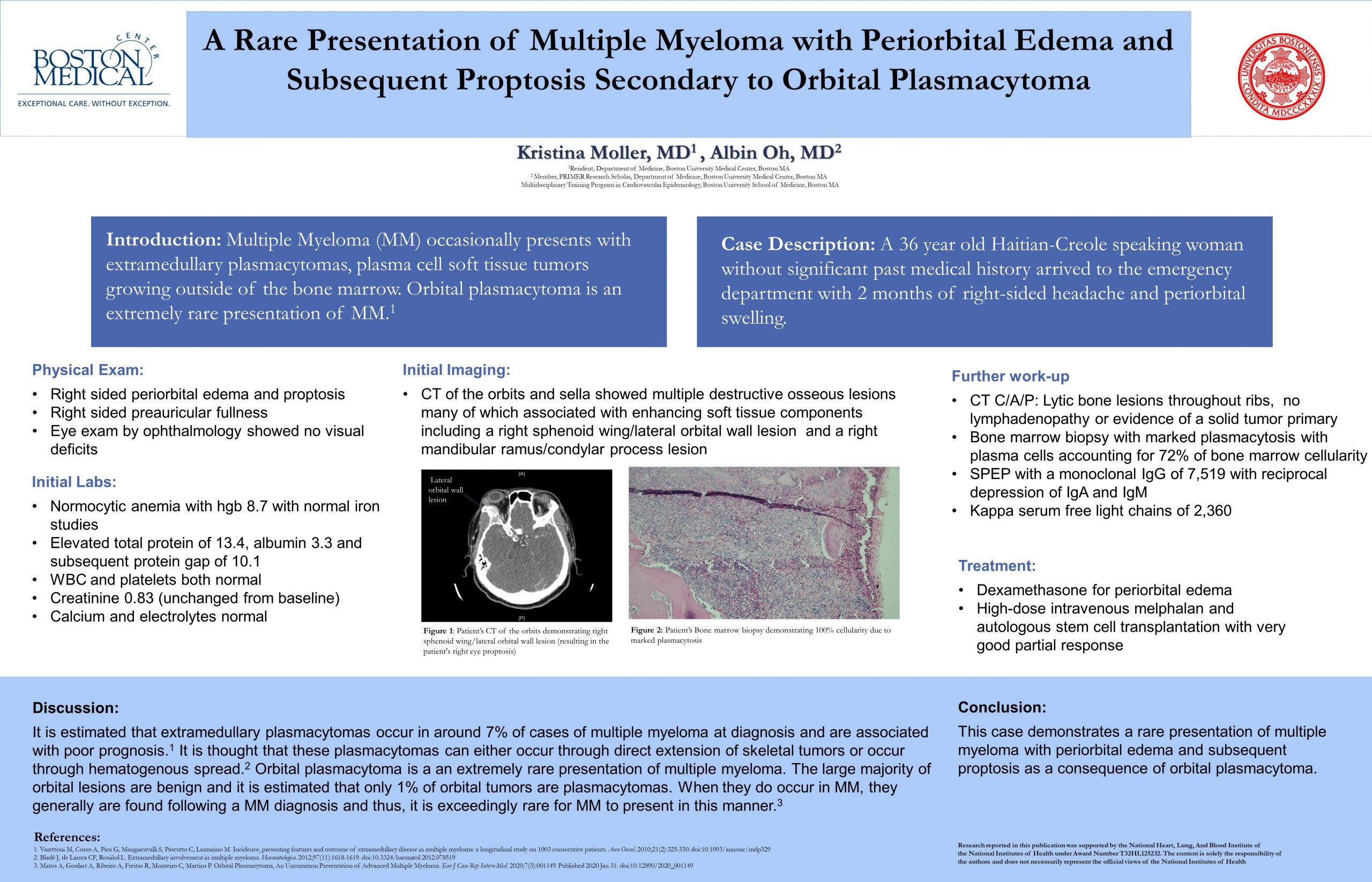Research Week 2022 – Kristina Moller, MD

A Rare Presentation of Multiple Myeloma with Periorbital Edema and Subsequent Proptosis Secondary to Orbital Plasmacytoma
Kristina Moller, MD, Resident, Department of Internal Medicine Residency Program, Boston University Medical Center, Boston MA
Albin Oh, MD, Member, PRIMER Research Scholar, Department of Medicine, Boston University Medical Center, Boston MA Multidisciplinary Training Program in Cardiovascular Epidemiology, Boston University School of Medicine, Boston MA
Learning Objectives:
- Define extramedullary plasmacytomas and discuss their presentation in multiple myeloma
- Become familiar with orbital plasmacytomas, a rare but important location for plasmacytoma
Multiple Myeloma (MM) occasionally presents with extramedullary plasmacytomas: plasma cell soft tissue tumors growing outside the bone marrow. It is estimated that extramedullary plasmacytomas occur in around 7% of MM cases at diagnosis and are associated with poor prognosis. It is thought that these plasmacytomas either occur through direct extension of skeletal tumors or via hematogenous spread. Orbital plasmacytoma is an extremely rare presentation of MM.
A 36 year old Haitian-Creole speaking woman without significant past medical history arrived at the emergency department with 2 months of right-sided headache and periorbital swelling. On presentation, the patient had normal vitals. Her physical exam was notable for right sided periorbital edema, proptosis and right-sided preauricular fullness. Ophthalmology completed a comprehensive eye exam which showed no visual deficits. Her labs demonstrated a normocytic anemia with a hemoglobin of 8.7 and an elevated total protein of 13.4 (albumin 3.3 with a protein gap of 10.1). Her remaining CBC, iron panel, and metabolic panel (including calcium and creatinine) were unremarkable. CT of the orbits and sella revealed multiple destructive osseous lesions. Many of these lesions were associated with enhancing soft tissue components including a right sphenoid wing/lateral orbital wall lesion (resulting in the patient’s right eye proptosis) and a right mandibular ramus/condylar process lesion (resulting in the patient’s right preauricular fullness).
Given the patient’s lab and imaging abnormalities the differential was initially broad, including an antibody-secreting lymphoma such as Waldenstrom macroglobulinemia or Burkitt’s lymphoma, multiple myeloma, or a metastatic solid tumor. Further imaging demonstrated lytic bone lesions throughout the ribs and pelvis but no evidence of a solid tumor primary or lymphadenopathy. The patient underwent a bone marrow biopsy and additional lab work that was significant for an SPEP with a monoclonal IgG of 7,519 with reciprocal depression of IgA and IgM. Kappa serum free light chains were elevated at 2,360. The bone marrow biopsy demonstrated marked plasmacytosis, with plasma cells accounting for 72% of bone marrow cellularity. The patient was diagnosed with multiple myeloma with extramedullary plasmacytomas. She was treated with dexamethasone for the periorbital edema, and discharged to hematology care where she eventually underwent high-dose intravenous melphalan and autologous stem cell transplantation with very good partial response.
Orbital plasmacytoma is an extremely rare presentation of multiple myeloma. The large majority of orbital lesions are benign and it is estimated that only 1% of orbital tumors are plasmacytomas. When they do occur in MM, plasmacytomas are generally found following a MM diagnosis; it is exceedingly rare for MM to present in this manner. This case demonstrates a rare presentation of multiple myeloma with periorbital edema and subsequent proptosis as a consequence of orbital plasmacytoma.
References
- Varettoni M, Corso A, Pica G, Mangiacavalli S, Pascutto C, Lazzarino M. Incidence, presenting features and outcome of extramedullary disease in multiple myeloma: a longitudinal study on 1003 consecutive patients. Ann Oncol. 2010;21(2):325-330. doi:10.1093/annonc/mdp329
- Bladé J, de Larrea CF, Rosiñol L. Extramedullary involvement in multiple myeloma. Haematologica. 2012;97(11):1618-1619. doi:10.3324/haematol.2012.078519
- Matos A, Goulart A, Ribeiro A, Freitas R, Monteiro C, Martins P. Orbital Plasmacytoma, An Uncommon Presentation of Advanced Multiple Myeloma. Eur J Case Rep Intern Med. 2020;7(3):001149. Published 2020 Jan 31. doi:10.12890/2020_001149